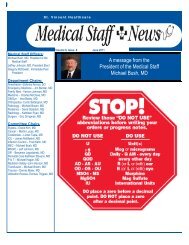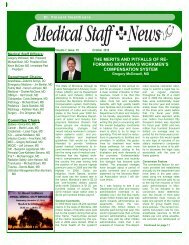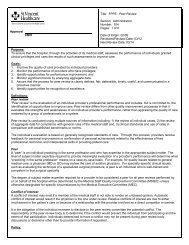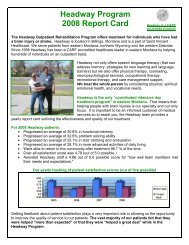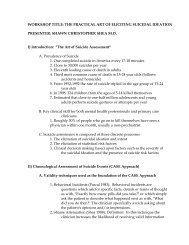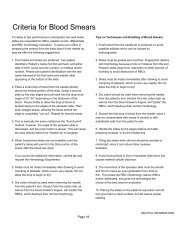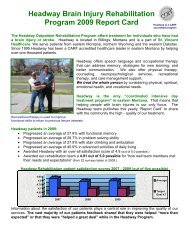AHA/ASA Guideline Guidelines for the Prevention of Stroke in ...
AHA/ASA Guideline Guidelines for the Prevention of Stroke in ...
AHA/ASA Guideline Guidelines for the Prevention of Stroke in ...
Create successful ePaper yourself
Turn your PDF publications into a flip-book with our unique Google optimized e-Paper software.
236 <strong>Stroke</strong> January 2011<strong>the</strong> metabolic syndrome has value <strong>in</strong> characteriz<strong>in</strong>g risk <strong>for</strong><strong>in</strong>dividual patients; simpler risk stratification <strong>in</strong>struments,such as <strong>the</strong> Fram<strong>in</strong>gham risk score, per<strong>for</strong>m as well or better<strong>in</strong> this regard. 157,158 Fur<strong>the</strong>rmore, <strong>the</strong> metabolic syndrome hasnot been associated with risk <strong>of</strong> develop<strong>in</strong>g cardiovasculardisease <strong>in</strong> <strong>the</strong> elderly (70 to 82 years <strong>of</strong> age), limit<strong>in</strong>g itsgeneralizability <strong>in</strong> a typical stroke population. 161The association between <strong>the</strong> metabolic syndrome and risk<strong>for</strong> first ischemic stroke has been exam<strong>in</strong>ed <strong>in</strong> several recentstudies, 158,162–170 all but one <strong>of</strong> which have confirmed <strong>the</strong>association. 168 The predictive value <strong>of</strong> <strong>the</strong> metabolic syndromerelative to its <strong>in</strong>dividual components or simpler compositerisk scores has not been adequately exam<strong>in</strong>ed. Onerecent analysis supports <strong>the</strong> view that classification <strong>of</strong> patientsaccord<strong>in</strong>g to <strong>the</strong> metabolic syndrome does not significantlyimprove estimation <strong>of</strong> stroke risk beyond what can beaccomplished with traditional risk factors. 170,171Only 1 study has exam<strong>in</strong>ed <strong>the</strong> association between <strong>the</strong>metabolic syndrome and risk <strong>for</strong> stroke recurrence. In <strong>the</strong>Warfar<strong>in</strong> Aspir<strong>in</strong> Symptomatic Intracranial Disease (WASID)trial, 206 participants with <strong>the</strong> metabolic syndrome were morelikely to have a stroke, MI, or vascular death dur<strong>in</strong>g 1.8 years<strong>of</strong> follow-up than participants without <strong>the</strong> metabolic syndrome(HR, 1.6; 95% CI, 1.1 to 2.4; P0.0097). Patients with<strong>the</strong> metabolic syndrome were also at <strong>in</strong>creased risk <strong>for</strong>ischemic stroke alone (HR, 1.7; 95% CI, 1.1 to 2.6;P0.012). Adjustment <strong>for</strong> components <strong>of</strong> <strong>the</strong> metabolicsyndrome attenuated <strong>the</strong> association <strong>for</strong> <strong>the</strong> composite outcomeand stroke alone, render<strong>in</strong>g <strong>the</strong> hazards ratio notstatistically significant. In addition, <strong>in</strong> a study <strong>of</strong> <strong>the</strong> impact <strong>of</strong>obesity and metabolic syndrome on risk factors <strong>in</strong> AfricanAmerican stroke survivors <strong>in</strong> <strong>the</strong> African American Antiplatelet<strong>Stroke</strong> <strong>Prevention</strong> Study, <strong>the</strong>re were <strong>in</strong>creas<strong>in</strong>g cardiovascularrisk factor pr<strong>of</strong>iles with <strong>in</strong>creas<strong>in</strong>g weight. 119The card<strong>in</strong>al features <strong>of</strong> <strong>the</strong> metabolic syndrome all improvewith weight loss. In particular, weight loss among menand women with <strong>the</strong> metabolic syndrome or obesity has beenshown to improve <strong>in</strong>sul<strong>in</strong> sensitivity, lower plasma glucose,lower plasma LDL-C, lower plasma triglycerides, raiseHDL-C, lower BP, reduce <strong>in</strong>flammation, improve fibr<strong>in</strong>olysis,and improve endo<strong>the</strong>lial function. 154,172,173No adequately powered randomized cl<strong>in</strong>ical trials have tested<strong>the</strong> effectiveness <strong>of</strong> weight loss, diet, or exercise <strong>for</strong> primaryprevention <strong>of</strong> stroke or o<strong>the</strong>r vascular cl<strong>in</strong>ical events amongpatients with <strong>the</strong> metabolic syndrome, although several areunder way. 174 No randomized trial <strong>of</strong> secondary prevention<strong>the</strong>rapy has been conducted among stroke patients with <strong>the</strong>metabolic syndrome. Until such trials are completed, preventive<strong>the</strong>rapy <strong>for</strong> patients with <strong>the</strong> metabolic syndrome should bedriven by <strong>the</strong> same characteristics that guide <strong>the</strong>rapy <strong>for</strong> patientswithout <strong>the</strong> metabolic syndrome, such as BP, age, weight,presence <strong>of</strong> diabetes, prior symptomatic vascular disease,LDL-C value, HDL-C value, renal function, and family history.Recommendations1. At this time, <strong>the</strong> utility <strong>of</strong> screen<strong>in</strong>g patients <strong>for</strong><strong>the</strong> metabolic syndrome after stroke has not beenestablished (Class IIb; Level <strong>of</strong> Evidence C).(New recommendation)Table 5. Prospective Trials Compar<strong>in</strong>g CarotidEndarterectomy and Medical TherapyTrial Mean Follow-Up Surgical Arm, %* Medical Arm, %*ECST 3 y 2.8 16.8NASCET 2.7 y 9 26VACS 11.9 mo 7.9 25.6ECST <strong>in</strong>dicates European Carotid Surgery Trial; NASCET, North AmericanSymptomatic Carotid Endarterectomy Trial; and VACS, Veterans Affairs CooperativeStudy Program.*Risk <strong>of</strong> fatal or nonfatal ipsilateral stroke.2. For patients who are screened and classified ashav<strong>in</strong>g <strong>the</strong> metabolic syndrome, management should<strong>in</strong>clude counsel<strong>in</strong>g <strong>for</strong> lifestyle modification (diet,exercise, and weight loss) <strong>for</strong> vascular risk reduction(Class I; Level <strong>of</strong> Evidence C). (New recommendation)3. Preventive care <strong>for</strong> patients with <strong>the</strong> metabolicsyndrome should <strong>in</strong>clude appropriate treatment <strong>for</strong><strong>in</strong>dividual components <strong>of</strong> <strong>the</strong> syndrome that are alsostroke risk factors, particularly dyslipidemia andhypertension (Class I; Level <strong>of</strong> Evidence A). (Newrecommendation; Table 4)II. Interventional Approaches <strong>for</strong> <strong>the</strong> PatientWith Large-Artery A<strong>the</strong>rosclerosisA. Symptomatic Extracranial Carotid DiseaseMany cl<strong>in</strong>ical trials, randomized and nonrandomized, compar<strong>in</strong>gsurgical <strong>in</strong>tervention (carotid endarterectomy [CEA])plus medical <strong>the</strong>rapy with medical <strong>the</strong>rapy alone, have beenper<strong>for</strong>med and published over <strong>the</strong> past 50 years. In <strong>the</strong>sestudies, several <strong>of</strong> which are described below, best medical<strong>the</strong>rapy did not <strong>in</strong>clude aggressive a<strong>the</strong>rosclerotic medicalmanagement, <strong>in</strong>clud<strong>in</strong>g use <strong>of</strong> HMG-CoA reductase <strong>in</strong>hibitors(stat<strong>in</strong>s), alternative antiplatelet agents such as clopidogrelor comb<strong>in</strong>ation susta<strong>in</strong>ed-release dipyridamoleaspir<strong>in</strong>,optimized BP control, and smok<strong>in</strong>g cessation <strong>the</strong>rapy.Surgical techniques have evolved as well. Fur<strong>the</strong>rmore, <strong>in</strong> <strong>the</strong>past few years, carotid angioplasty and stent<strong>in</strong>g (CAS) hasemerged as an alternative treatment <strong>for</strong> stroke prevention <strong>in</strong>patients deemed at high risk <strong>for</strong> conventional endarterectomy.Ongo<strong>in</strong>g cl<strong>in</strong>ical trials are compar<strong>in</strong>g <strong>the</strong> efficacy <strong>of</strong> CASwith <strong>the</strong> gold standard CEA.Carotid EndarterectomyThree major prospective randomized trials have demonstrated<strong>the</strong> superiority <strong>of</strong> CEA plus medical <strong>the</strong>rapy over medical<strong>the</strong>rapy alone <strong>for</strong> symptomatic patients with a high-grade(70% on angiography) a<strong>the</strong>rosclerotic carotid stenosis. 175–177The European Carotid Surgery trial (ECST), <strong>the</strong> NorthAmerican Symptomatic Carotid Endarterectomy Trial(NASCET), and <strong>the</strong> Veterans Affairs Cooperative StudyProgram (VACS) each showed outcomes support<strong>in</strong>g CEAwith moderate-term follow-up (Table 5). Symptomatic patients<strong>in</strong>cluded those who had both 70% ipsilateral carotidstenosis and TIAs, transient monocular bl<strong>in</strong>dness, or nondisabl<strong>in</strong>gstrokes. Pooled analysis <strong>of</strong> <strong>the</strong> 3 largest randomizedtrials <strong>in</strong>volv<strong>in</strong>g 3000 symptomatic patients (VACS,NASCET, and ECST) found a 30-day stroke and death rate<strong>of</strong> 7.1% <strong>in</strong> surgically treated patients. 178 Additionally, eachDownloaded from stroke.ahajournals.org by on March 8, 2011



